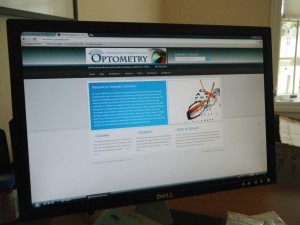Adults are exposed to screens – TVs, cell phones, computers, etc – for nearly 8 1/2 hours on any given day. And children, 8 to 18 years old can spend 7 1/2 hours a day using smart phones, computers, TV or some other electronic device. Is it any wonder so many of us suffer from visual stress?
According to the American Optometric Association, Computer increasing Vision Syndrome (CVS) consists of blurred vision, dry eyes, eyestrain, headaches, double vision, color distortion, light sensitivity and neck, should and back pain due to prolonged computer use. These symptoms have been associated with poor digital display lighting, display glare, poor seating posture, improper viewing distances from one’s face to the digital display and uncorrected vision problems, such as hyperopia, astigmatism and inadequate eye focusing. In addition, presbyopia, due to its accommodative issues, can contribute to CVS symptoms as well. Those at greatest risk for developing CVS are those who generally use a computer three or more continuous hours daily.CVS occurs because computer work challenges the visual system in the following ways: 
- The letters on a computer display are often not as precise or sharply defined as a printed letter.
- The level of contrast of the letters to the background on the display is decreased.
- A digital display often has glare and reflections, challenging one’s view.
- The viewing distances and angles associated with using a computer require certain focusing and eye movement needs.
As a result of the aforementioned causes, computer users who already wear spectacles or contact lenses may find they are not helpful. For instance, the spectacle wearer may tilt his head at an odd angle because his lenses aren’t designed for viewing a digital display. Or he may bend toward the display to achieve clarity. These body positions can cause muscle or neck, should and back pain.
If you are 40 years of age or older, the stress of viewing a computer screen is probably compounded by presbyopia: your eyes no longer accommodate, or focus, to read. (You may have noticed that your arms seem shorter.) Bifocals are often prescribed between the ages of 40 and 50, to allow you to see a distant object and also focus downward and close-up.
For someone who spends more than a couple of hours a day in front of a computer screen, a pair of glasses designed specifically for that task is the best solution. Do you wear cleats for golf? Flip-flops at the beach? Old tennis shoes to wash the dog? Do you have special shoes for special events? One pair of shoes can not fill every need; a single pair of glasses does not either.
A lens designed especially for the computer is recommended. It may be a single vision lens or a specifically designed multifocal.
For some computer users, CVS symptoms are temporary and abate once ceasing computer work. If the symptoms aren’t addressed, they can continue and may worsen upon further computer use.
Ways to alleviate eyestrain from computer use:
- Adjust your environment so the room isn’t as bright
- Lower your monitor so you are looking downward
- Increase awareness of your blinking. Blink more frequently to keep vision clear and eyes moist.
- Wear appropriate visual correction. A small prescription can have a large impact on your eyes with visually demanding computer work.
One thought to “Computer Vision”